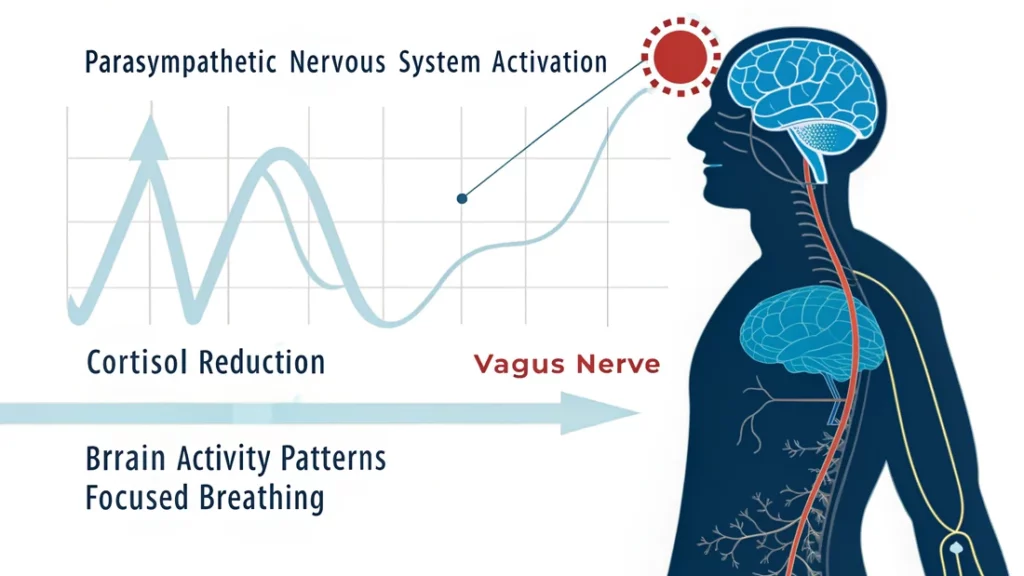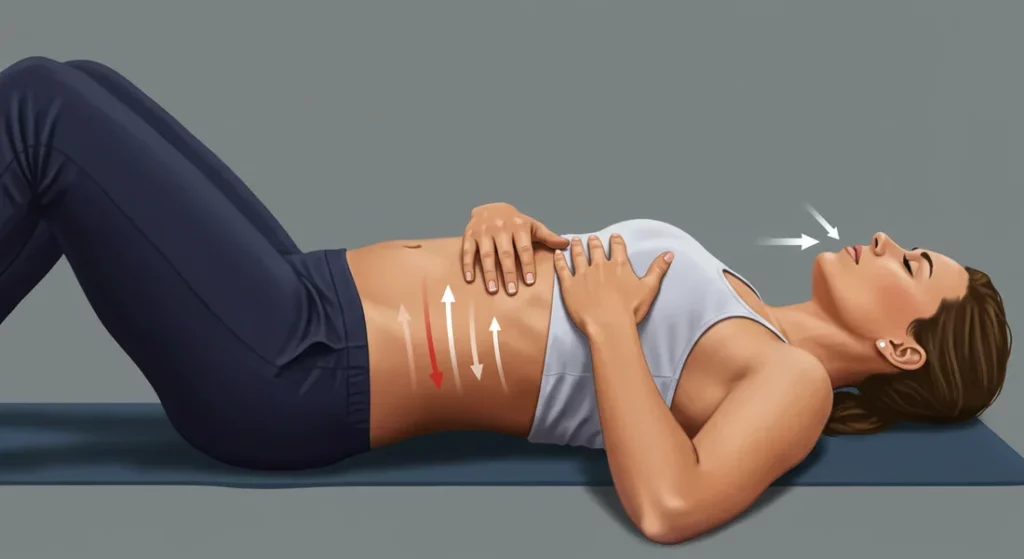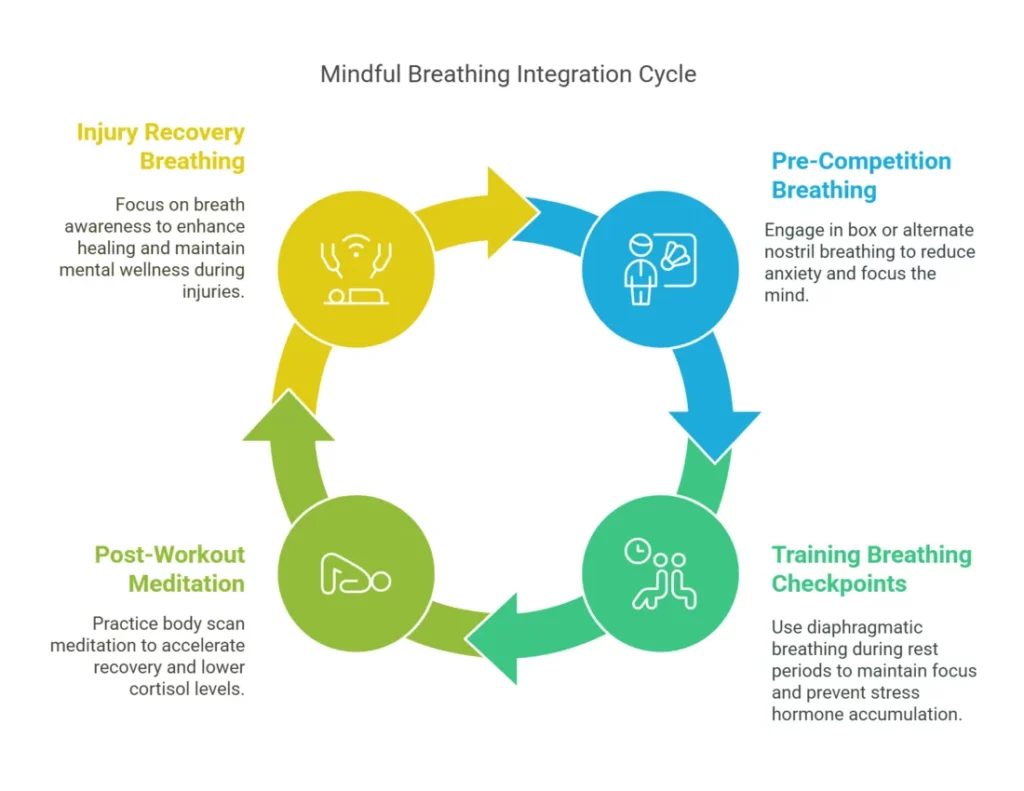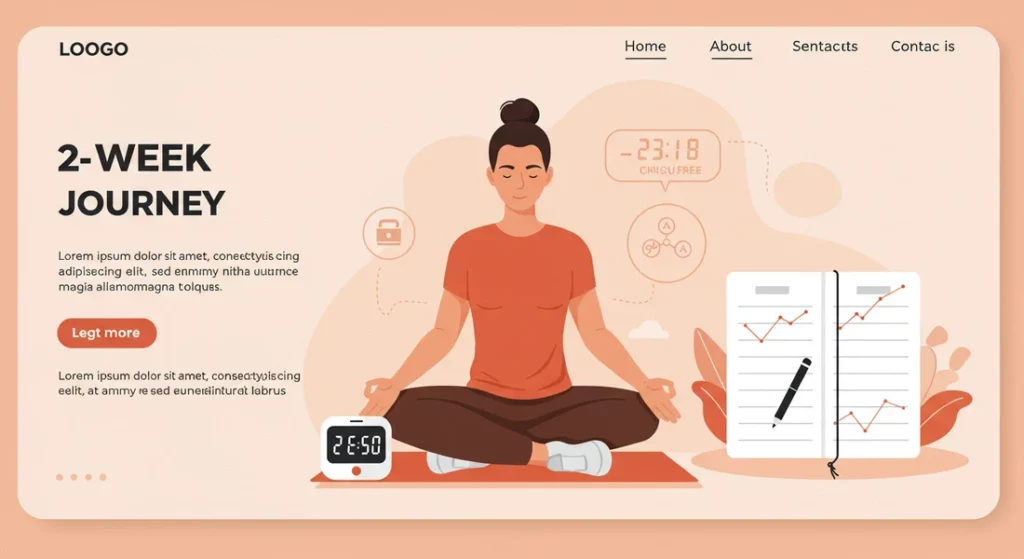You’ve been there before.
The pressure mounting as you prepare to step onto the field. Your heart racing before the starting gun.
That moment of doubt as you face a formidable opponent.
As an athlete, you know these feelings all too well—the stress, pressure, and self-doubt that can make the difference between victory and defeat.

What if one simple, always-available tool could help you regain control in these crucial moments?
Breath awareness is that tool—and it’s much more than just taking deep breaths.
It’s the practice of observing your breathing pattern without judgment, becoming attuned to each inhale and exhale.
This non-judgmental observation creates a powerful foundation for performance excellence.
Unlike passive breathing techniques, breath awareness empowers you to take control of your internal state, regardless of external circumstances.
By consciously directing your attention to your breath, you gain mastery over your most fundamental physiological process.
The benefits for athletes are substantial:
- Unlocking peak performance when it matters most
- Reducing pre-competition anxiety and in-game stress
- Cultivating laser-like mental focus during critical moments
- Accelerating recovery between training sessions
Let’s explore how this simple yet profound practice can transform your athletic performance.
The Science of Mindful Breathing
The power of mindful breathing isn’t just anecdotal—it’s backed by solid science.
When you engage in mindful breathing, you activate your parasympathetic nervous system—often called your “rest and digest” mode—which counteracts the “fight or flight” response triggered by stress.
This physiological shift has profound effects on your body and mind as an athlete.
Research published in the Journal of Sports Sciences has shown that just five minutes of mindful breathing can significantly lower cortisol, a primary stress hormone that can inhibit performance when elevated.
When cortisol levels decrease, your body can better allocate energy to performance rather than stress responses.
The vagus nerve plays a crucial role in this process.
As the longest cranial nerve in your body, it connects your brain to key organs including your heart, lungs, and digestive system.
Regular mindful breathing stimulates this nerve, improving what scientists call “vagal tone”—essentially strengthening your body’s ability to relax after stress, a vital skill for athletes who need to transition quickly between high intensity and recovery.
Beyond the physiological benefits, mindful breathing trains your attention muscles.
A 2020 study in the International Journal of Psychophysiology found that athletes who practiced mindful breathing for eight weeks showed measurable improvements in attentional control—the ability to focus on relevant cues while filtering out distractions.

References:
- Brown, R.P., & Gerbarg, P.L. (2005). Sudarshan Kriya yogic breathing in the treatment of stress, anxiety, and depression: Part I—neurophysiological model. Journal of Alternative and Complementary Medicine, 11(1), 189-201.
- Zaccaro, A., et al. (2018). How breath-control can change your life: A systematic review on psycho-physiological correlates of slow breathing. Frontiers in Human Neuroscience, 12, 353.
Mindful Breathing Techniques for Athletes
Let’s explore four powerful breathing techniques specifically beneficial for athletes.
Each technique serves different purposes, from pre-competition calming to mid-workout focus enhancement.
1. Diaphragmatic Breathing (Belly Breathing)

Step-by-Step Instructions:
- Lie down or sit comfortably with one hand on your chest and one on your belly.
- Breathe in slowly through your nose, ensuring your belly (not your chest) rises.
- Exhale slowly through your mouth, feeling your belly fall.
- Continue for 3-5 minutes, focusing on the sensation of your breath filling your lower lungs.
Benefits: Increases oxygen efficiency, activates the parasympathetic nervous system, and establishes a strong foundation for all other breathing techniques.
Pro Tip: Practice this technique during rest periods between sets to accelerate recovery and maintain focus during training.
2. Box Breathing

Step-by-Step Instructions:
- Sit upright with your feet flat on the floor.
- Inhale through your nose for a count of 4.
- Hold your breath for a count of 4.
- Exhale through your mouth for a count of 4.
- Hold your breath (lungs empty) for a count of 4.
- Repeat for 3-5 minutes.
Benefits: Quickly calms pre-competition nerves, improves concentration, and regulates autonomic nervous system function.
Pro Tip: Use this technique immediately before competition to center yourself and establish a focused mental state.
3. Alternate Nostril Breathing (Nadi Shodhana)

Step-by-Step Instructions:
- Sit comfortably with your spine straight.
- Rest your left hand on your left knee.
- Use your right thumb to close your right nostril.
- Inhale deeply through your left nostril.
- Use your right ring finger to close your left nostril and release your thumb.
- Exhale through your right nostril.
- Inhale through your right nostril.
- Close your right nostril with your thumb, release your ring finger.
- Exhale through your left nostril.
- Repeat for 5-10 cycles.
Benefits: Balances energy, improves focus, and calms the mind before high-pressure situations.
Pro Tip: Practice this technique during recovery days to enhance mind-body connection and mental clarity.
4. Body Scan Meditation with Breath Focus

Step-by-Step Instructions:
- Lie down or sit comfortably with your eyes closed.
- Take several deep breaths to settle in.
- Beginning with your toes, direct your breath and attention to each body part.
- Notice any tension and consciously release it with each exhale.
- Move progressively up your body—feet, calves, knees, thighs, and so on.
- With each inhale, imagine oxygen flowing to that body part.
- With each exhale, imagine tension leaving.
- Continue until you’ve scanned your entire body.
Benefits: Enhances body awareness, identifies areas of tension, accelerates recovery, and improves mind-body connection.
Pro Tip: Use this technique after intense training sessions to accelerate recovery and prevent injury by identifying areas of tension.
Quick Reference Chart
| Technique | When to Use | Primary Benefits | Duration |
| Diaphragmatic Breathing | Daily practice, during rest periods | Oxygen efficiency, foundation building | 3-5 minutes |
| Box Breathing | Pre-competition, high-stress moments | Quick calming, focus enhancement | 3-5 minutes |
| Alternate Nostril Breathing | Recovery days, pre-training | Energy balancing, mental clarity | 5-10 cycles |
| Body Scan | Post-workout, before sleep | Enhanced recovery, body awareness | 10-15 minutes |
Integrating Mindful Breathing into Training & Competition

The true power of mindful breathing comes from integrating it strategically throughout your athletic routine.
Pre-workout/competition
Use box breathing or alternate nostril breathing 10-15 minutes before your event.
This primes your nervous system for optimal performance, reduces pre-competition anxiety, and establishes a focused mindset.
Olympic swimmer Michael Phelps famously used pre-race breathing routines to center himself before his record-breaking performances.
Integration Tip: Create a pre-competition ritual that includes 3-5 minutes of mindful breathing, ideally in a quiet space away from distractions.
During training
Incorporate diaphragmatic breathing during rest periods between sets or intervals.
This accelerates recovery, maintains focus, and prevents the accumulation of stress hormones during long training sessions.
Integration Tip: Set specific breathing checkpoints during your workout—for example, five conscious breaths between each set or during recovery intervals.
Post-workout/competition
Practice body scan meditation with breath focus to accelerate recovery, reduce cortisol levels, and transition your body from performance mode to recovery mode.
Integration Tip: Schedule a 10-minute body scan meditation within 30 minutes of completing your workout or competition.
During injury recovery
Mindful breathing techniques can significantly enhance the injury recovery process by reducing stress (which impedes healing), improving circulation to injured areas, and maintaining mental wellness during forced breaks from training.
Integration Tip: Practice longer breath awareness sessions (15-20 minutes) during injury recovery periods, directing breath mentally toward injured areas.
Consistency is the key to making these techniques effective.
Just as you wouldn’t expect strength gains from a single weightlifting session, the benefits of mindful breathing come from regular practice.
Start with 5 minutes daily, then gradually expand to incorporating these techniques throughout your training cycle.
Overcoming Challenges and Staying Consistent
Even knowing the benefits, many athletes struggle to maintain a consistent breathing practice.
Here’s how to overcome common challenges:
Finding time
- Challenge: “I don’t have time for another training element.”
- Solution: Integrate breathing work into existing routines rather than adding separate sessions. Use the first 5 minutes of your warm-up or cool-down, or practice while in transit to training.
- Action step: Identify three existing daily activities (shower, commute, pre-sleep) where you can incorporate 2-3 minutes of mindful breathing.
Dealing with distractions
- Challenge: “My mind wanders constantly during breathing exercises.”
- Solution: Start with shorter sessions and use external cues like timer sounds or counting to maintain focus. Remember that noticing distraction is part of the practice.
- Action step: Download a breathing app with guided sessions specifically designed for athletes (recommendations in the Resources section).
Tracking progress
- Challenge: “I’m not sure if it’s making a difference.”
- Solution: Keep a breathing journal noting how you feel before and after sessions. Track performance metrics alongside breathing consistency to identify correlations.
- Action step: Create a simple 1-10 rating system for focus, stress, and performance, and track these metrics daily alongside your breathing practice.
Staying motivated
- Challenge: “I lose motivation when I don’t see immediate results.”
- Solution: Set specific, breathing-related goals like “5 minutes of diaphragmatic breathing before each workout for two weeks.” Celebrate these achievements regardless of performance outcomes.
- Action step: Find a teammate or training partner to practice mindful breathing with, creating accountability and shared experience.
Real-World Success Stories

Elite Athletes
Sarah Johnson, Olympic Track Cyclist: “Before discovering mindful breathing, pre-race anxiety would drain my energy before I even got to the starting line. Now, after six months of consistent practice, I use box breathing before every race. Not only has my heart rate variability improved by 15%, but my coach has noticed I’m much more present during tactical discussions just before races.”
Marcus Taylor, NBA Point Guard: “During high-pressure free throws, my mind used to race with thoughts about the score, the crowd, everything but the shot itself. Working with our team performance psychologist, I developed a three-breath routine that instantly centers me. My free throw percentage has improved from 82% to 91% this season.”
Amateur Athletes
David Chen, Marathon Runner: “As a 45-year-old recreational runner, recovery between training sessions was becoming my biggest challenge. The body scan breathing technique has transformed my recovery. I’m now able to maintain my four-day training schedule without the persistent fatigue I used to experience.”
Emma Williams, College Soccer Player: “Alternate nostril breathing helped me manage academic stress during championship season. Instead of bringing classroom stress onto the field, I use this technique during our pre-game warmup. My coach commented that my decision-making under pressure has noticeably improved.”
These real-world examples demonstrate that mindful breathing benefits athletes across all levels and sports—the common thread being consistent practice and strategic implementation.
Resources and Tools
Apps
- Breathe Athletics – Designed specifically for athletes with sport-specific breathing protocols
- Headspace for Sport – Features breathing exercises tailored to pre-competition, competition, and recovery
- Wim Hof Method – Advanced breathing techniques for performance and recovery
Books
- “Breath: The New Science of a Lost Art” by James Nestor -Reveals scientifically-backed breathing techniques to increase oxygen efficiency, reduce inflammation, and enhance recovery for athletes.
- “The Oxygen Advantage” by Patrick McKeown – Teaches specialized breathing exercises to improve CO2 tolerance, reduce breathlessness, and boost performance in endurance sports.
- “Mind Gym: An Athlete’s Guide to Inner Excellence” by Gary Mack – Integrates breathing with mental training to build resilience, overcome anxiety, and establish effective pre-competition routines.
Websites
- Breathing For Athletes – Free sport-specific tutorials, assessments, and protocols based on latest breathing research for athletic performance.
- Performance Breathe – Comprehensive library of sport-specific breathing protocols backed by physiological data and case studies.
Training Tools
- Breath metronomes – Guide precise breathing patterns customized to your training goals, eliminating guesswork during practice.
- Heart rate variability monitors – Track how breathing affects your nervous system to optimize recovery and performance timing.
- Breathing bands – Provide physical feedback ensuring proper diaphragmatic technique and preventing inefficient chest-breathing during training.
FAQ
Q: How long before I notice benefits from mindful breathing? A: Most athletes report subtle improvements in focus and stress management within the first week of daily practice. Measurable performance benefits typically emerge after 3-4 weeks of consistent practice.
Q: Can mindful breathing help with performance anxiety? A: Yes, particularly box breathing and alternate nostril techniques. These methods quickly activate your parasympathetic nervous system, reducing anxiety symptoms like racing heart and circular thoughts.
Q: Should I breathe through my nose or mouth during exercise? A: For most training, nasal breathing provides superior benefits including better oxygen uptake, natural air filtration, and improved CO2 tolerance. However, during high-intensity intervals, a combination of nasal inhaling and mouth exhaling may be necessary.
Q: How can I remember to use these techniques during competition? A: Incorporate mindful breathing into your pre-competition routine and establish breathing cues tied to specific moments (like between plays or during breaks). Eventually, these will become automatic performance triggers.
Q: Can mindful breathing improve my endurance? A: Yes. Regular practice of diaphragmatic breathing strengthens respiratory muscles and improves oxygen efficiency, potentially enhancing endurance performance by 5-10% according to recent studies.
Conclusion & Call to Action

The breath is your most powerful and accessible performance tool—always available, completely free, and profoundly effective when used correctly.
As we’ve explored, mindful breathing offers athletes a remarkable range of benefits:
- Physiological advantages through nervous system regulation
- Mental performance enhancement through improved focus and attention
- Accelerated recovery through stress hormone reduction
- Emotional resilience in high-pressure situations
- Improved mind-body connection for better movement quality
Unlike many performance enhancement strategies that require significant investments of time, money, or resources, mindful breathing requires only your attention and consistency.
Your challenge now is simple: commit to five minutes of mindful breathing daily for the next two weeks.
Whether you choose diaphragmatic breathing, box breathing, or any other technique discussed, the key is consistency.
Track your experience, notice the subtle changes in your training quality and mental state, and gradually integrate these techniques more deeply into your athletic routine.
The breath has been powering human performance for millennia.
It’s time to harness its full potential in your athletic journey.
Begin today. Breathe mindfully. Perform extraordinarily.
Related Posts
No posts
